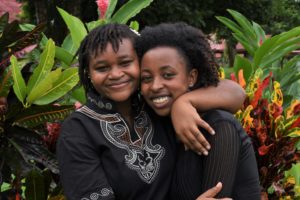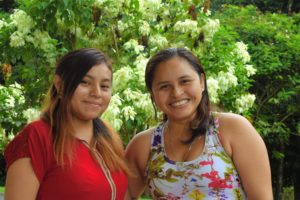Graduation projects: Innovating for the environment
During the final year of their undergraduate studies, each EARTH University student develops and executes an extensive graduation project. It is a space to pursue their diverse areas of interest as well as apply the research know-how acquired throughout the preceding three years of study.
At the end of their fourth year, students share with the EARTH community the results of their project. In 2019, more than 70 projects were completed in different branches of agronomy. Continue reading to learn about three of them, each focused on a unique element of environmental sustainability.
Bamboo as an energy alternative
Through their project, Tseganesh Sete (’19, Ethiopia) and Jacqueline Nyawira (’19, Kenya) set out to help the nomadic women in African nations who dedicate a lot of time to chopping trees and collecting wood – a common energy source for cooking food and heating homes. Beyond the immense investment of time, the practice involves incredible risks to bodily safety.
The students collaborated to develop burnable pellets of bamboo, pineapple leaves and coconut fiber as an eco-friendlier alternative to traditional wood. “Instead of cutting down trees, they can use agricultural waste,” Tseganesh explains. “Bamboo reaches maturity in three to five years, so it is easier to produce and use. Also, this option is denser and contains the necessary elements to be converted into energy. We mix it with waste, and it becomes more efficient.”
Their project allowed them to discover new talents. “As an agronomist, I thought the subject of energy was far off and that I did not have the ability to conduct an experiment of this kind from scratch,” Jacqueline says. “But this project has shown me my many skills in science and the breadth of agronomy as a discipline.” Although coconut and pineapple – both tropical crops – are not found in all regions of Africa, the students assure that other local crops can be easily substituted when necessary.
Water-optimization pots
Interested in hydroponics and vertical agriculture, Douglas Hernández (’19, Ecuador) developed an at-home produce planter for use in water-scarce places. After conducting user surveys and a market analysis, he determined that people need pots that can maintain plants without requiring a lot of care. “People expressed a desire for pots and to understand basic things, such as soil moisture, fertility and resource optimization,” Douglas says. Additionally, he prioritized developing a prototype from sturdy, recyclable materials.
Douglas would like his project to grow into a buy-one-give-one business in which for each pot purchased, another one is donated to a low-income family in a water-scarce area. He also wants to design a set of stackable pots that people can use for small-scale vertical agriculture – a system in which a minimal amount of inputs (water, fertilizers, etc.) is used hyper-efficiently.
Biochar for wastewater treatment
Genny May Carrillo (’19, Mexico) and María Daniela Tun (’19, Mexico) dedicated their project to the production of biochar from pineapple stubble (aka crop waste such as stalks and leaves). Their interest in it arose from the ubiquity of the crop in the Costa Rican economy. “We wanted to work on something that would have a positive impact on the environment, make use of the waste generated at this type of plantation, and give it new value,” Genny says.
Genny and María Daniela sourced pineapple leaves from Ojo de Agua farm, located near EARTH’s Guácimo Campus. They subjected the leaves to pyrolysis (aka high-heat, oxygen-free decomposition), which yielded biochar. Later, the two students tested the product without activating it in water. They built filters from plastic bottles, cotton, sand and gravel, placed the biochar atop the device, and allowed water to pass through.
“We used two types of stubble: one with paraquat – which is a type of herbicide – and another without any chemicals,” Genny explains. “The results indicated that, in both scenarios, the water was contaminated. The most surprising thing was that the stubble with paraquat showed lower levels of contamination.” They believe that future studies would enable a fuller understanding of 1) the impact of herbicides and other chemicals and 2) the use of alternative products like biochar for wastewater treatment. In addition, the project allowed the duo to demonstrate the value of crop stubble – as a new revenue stream for farmers, with a small environmental footprint.
Through their graduation projects, fourth-year students showcase their environmental leadership – seeking innovative and effective solutions to problems generated by human activity. Under the guidance of faculty, students dedicate 35 weeks to putting their techno-scientific knowledge into practice. Thanks to EARTH’s dynamic and participatory academic model, they are implementing much-needed solutions to issues within sustainable agriculture, rural lifeways, and natural resource management.







